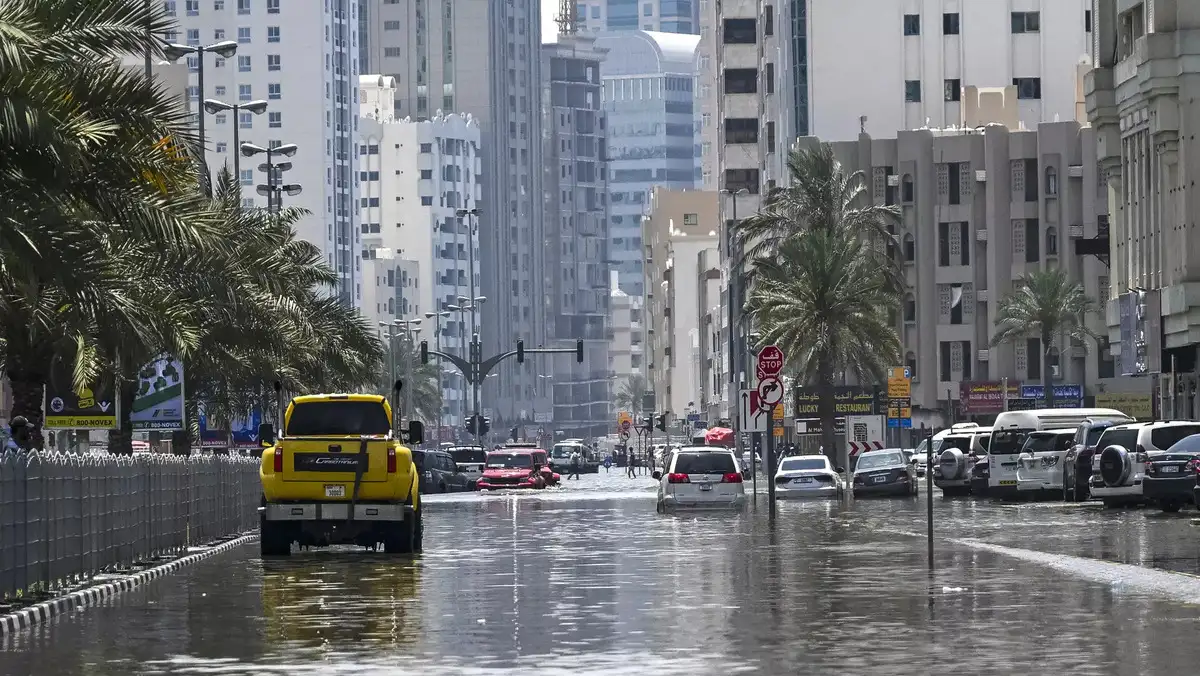Now Reading: UAE Deserts Turning Green? Rainfall Brings Surprising Change 2025
-
01
UAE Deserts Turning Green? Rainfall Brings Surprising Change 2025
UAE Deserts Turning Green? Rainfall Brings Surprising Change 2025

Table of Contents
The deserts of the United Arab Emirates (UAE) are known for their scorching heat, shifting dunes, and extremely dry climate. But in recent years, a surprising and rare phenomenon has started making headlines—rainwater falling in the heart of the UAE’s vast desert regions. While rain in the UAE is still uncommon, its increasing presence in desert areas is raising both hope and concern among scientists, environmentalists, and local residents.
A Country Not Known for Rain

The UAE, made up of seven emirates including Abu Dhabi, Dubai, and Sharjah, lies in one of the driest regions on Earth. Most of the country gets less than 100mm of rainfall annually. Summer temperatures can soar above 50°C (122°F), and water has always been a precious resource.
Yet, over the last decade, climate patterns have slowly shifted. Occasional cloud seeding programs and changes in regional weather systems have led to more frequent, though still rare, rain events across the country—including the barren desert.
When Rain Hits the Desert
When rainwater hits desert sand, it doesn’t behave the way it would in more fertile regions. Much of the water is absorbed quickly into the ground, while some evaporates due to high temperatures. But when rain is heavy, even for a short time, it transforms the desert landscape almost overnight.
In some areas, desert shrubs and plants that had lain dormant begin to sprout and bloom. Shallow puddles form, attracting birds, insects, and even some reptiles. These short bursts of life provide a rare opportunity for locals and tourists to witness the desert in full color.
“It’s like watching a miracle,” says Fatima Al Mazrouei, an environmental researcher from Al Ain. “You see flowers you didn’t know existed. The air feels different. It gives people hope.”
Cloud Seeding’s Role in Rainfall
The UAE is one of the few countries that have invested heavily in cloud seeding, a process where aircraft release salt particles into the sky to encourage rain formation. This technology, while controversial, is believed to contribute to some of the rainfall observed in recent years.
According to the National Center of Meteorology (NCM) in the UAE, more than 200 cloud seeding missions were conducted in 2024 alone. While cloud seeding cannot create storms, it can enhance existing clouds to produce more rain, particularly in the summer and autumn months.
Some scientists caution that this could lead to unexpected consequences, such as flooding in poorly prepared areas, especially in the desert where natural drainage is limited.
Challenges of Sudden Rainfall
While rainwater may sound like a blessing, it also presents serious challenges to the UAE’s desert infrastructure. Roads in desert regions are often not built with heavy rain in mind. Sudden storms can cause flooding, road collapses, and even damage to homes and farms.
“We love the rain, but it can be dangerous too,” explains Ahmed bin Sultan, a farmer in Liwa Oasis. “One big storm and our crops or irrigation systems could be washed away.”
Water that runs off rather than soaking into the soil often ends up wasted, unless quickly captured. To tackle this, the UAE has begun investing in rainwater harvesting and underground water storage solutions, especially in desert regions.
Environmental and Agricultural Benefits
Despite the risks, rainwater in the UAE deserts also brings new hope for sustainability. Experts believe that if harnessed correctly, seasonal rain can support:
- Desert farming: Boosting the growth of salt-tolerant and drought-resistant crops.
- Biodiversity: Supporting native plants and attracting rare desert animals and birds.
- Soil enrichment: Replenishing nutrients in sandy soils, making them more fertile.
Researchers from the UAE University are currently studying how rainfall affects groundwater levels and desert soil quality. The goal is to develop long-term strategies that turn rare rainfall into lasting benefit.
“If we can capture and store even a fraction of this water,” says Dr. Reem Al Suwaidi, a sustainability expert, “we can change the future of our deserts.”
Climate Change or Natural Variation?

The increase in desert rainfall raises a big question: Is this a sign of climate change? Experts are divided. Some believe that rising global temperatures are altering weather systems and increasing rainfall in unexpected regions. Others suggest it may be part of a natural regional cycle that occurs every few decades.
What is clear is that the UAE must be prepared. The nation’s Vision 2031 already includes water security and desert greening as major goals, and desert rainfall may play a crucial role in that strategy.
Social and Cultural Impact
For many Emiratis, rain—especially in the desert—is seen as a sign of blessing. Social media lights up with photos of flooded wadis, children playing in puddles, and rare flowers blooming in the sand.
Desert rain even features in traditional poetry and songs, often linked to themes of renewal and divine mercy.
“When it rains in the desert, it reminds us of our roots,” says poet Saif Al Kaabi. “It tells us the land is alive, still listening, still growing.”
Looking Ahead
The rare but growing occurrence of rainwater in UAE deserts is reshaping how the country thinks about its environment, future development, and water resources. From scientific research to cultural celebration, desert rainfall is becoming more than a weather event—it’s a symbol of possibility in the face of climate uncertainty.
As the UAE balances growth with sustainability, the rain in its deserts may offer a golden opportunity—if managed wisely.
Final Thoughts
Rain in the desert may once have seemed impossible, but today, it’s a real and growing phenomenon in the UAE. With careful planning and investment, this rare gift from the skies could help transform one of the driest places on Earth into a model of sustainable living and innovation.
Read More:- Portugal’s Dama Art Gallery Takes Global Lead in Art Movement Now 2025






















